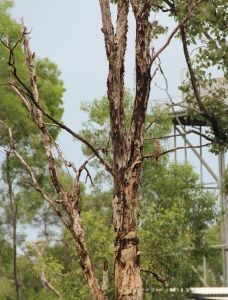It’s quite common to find an easement on your property. An easement is a small piece of land utilities, and councils can access or install infrastructure.
If there’s an easement on your property, it will be registered on your land title and contain Power and Water infrastructure such as manholes, sewer and water pipelines and powerlines.
Easements are necessary to protect your electricity and water supplies as well as wastewater collection. The law allows us to enter your property at any time with suitable notice to maintain or repair the power, water and sewerage networks.
Wherever possible, Power and Water infrastructure is located within road reserves. In most instances, the point of services for the land is located near the front boundary of the property without the need for easements to be granted. However sometimes Power and Water need to install infrastructure to supply new customers or to maintain or improve equipment for existing services. If this can’t be done using public land it is achieved by creating easements.
The purpose of an easement is to safeguard Power and Water’s right of access to construct, inspect, operate, repair, replace and maintain assets located on private property and to regulate the activities of others within the easement to ensure the safety of all people and safe and reliable operation of the asset. An easement allows full access by Power and Water personnel at all times, subject to normal notification requirements.
Regardless of whether a formal easement exists, the same rights apply over any water and sewerage infrastructure operated by Power and Water.
How do I know if there are easements on my property?
Generally, a search undertaken at the Land Titles Office will determine whether an easement is registered on the Certificate of Title to your land.
However, there are some instances where easements are not registered on the Certificate of Title. You can contact Power and Water on 1800 245 092 to ask us if we have an easement registered or lodge a request through Before You Dig Australia (BYDA)
You’ll find a full list of Land Titles Offices in the Northern Territory here.
Your responsibilities
If you have an easement, you can use the area but must make sure we can still access the infrastructure, including underground pipes and cables.
The area needs to be kept clear of any obstructions that may prevent access to the assets and/or any underlying pipes or cables. Manholes need to be kept free of garden fillers such as gravel, sand and soil. In some cases manholes can be moved or raised with varying costs to the property owner.
Consider your future landscaping, including the position of your swimming pool or garden shed.
Generally, suitable coverage over an easement includes lawn, shrubs or trees. Trees which develop vast and invasive roots aren't appropriate to plant over or near easements. Large trees can crack and break pipes causing burst water mains, blocked sewers or damage to conduits. Learn more about allowable planting on Power and Water easements.
Any construction over or within the easement on your property requires our written consent.
Where development occurs on a property with an existing sewer or water easement, we must be notified and a suitable arrangement developed to allow protection of the existing assets during development of the site.
Where there's gated access to an easement, you may need a Power and Water lock to enable continued access.
To arrange for a Power and Water padlock (with a fully-refundable deposit), please contact us.




